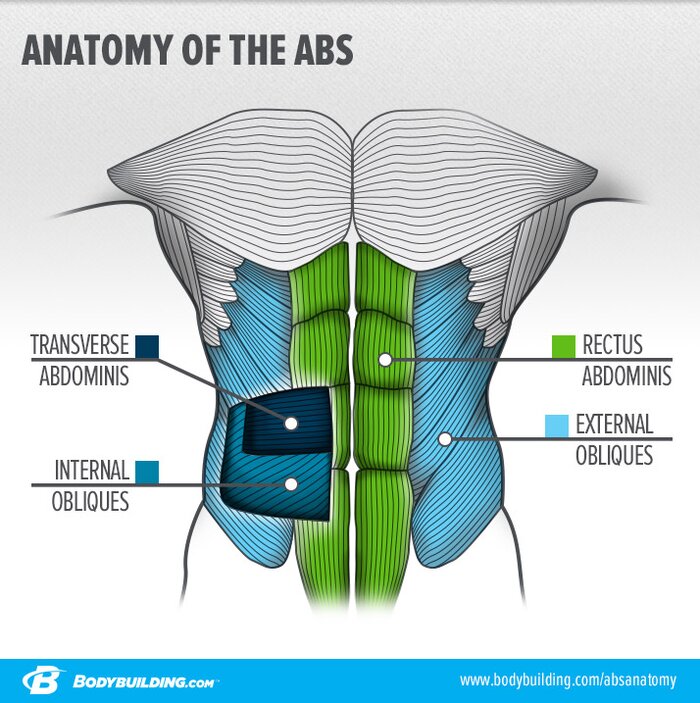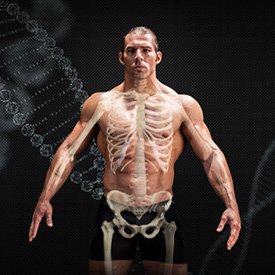Muscle Growth | Arms | Legs | Back | Chest | Shoulders | Core
Many people's ab workouts rarely go beyond what's required to chase a six-pack. Developing true core strength—the kind that will protect your back, make you strong, and still give you that muscle definition you crave—requires a more comprehensive approach.
Learn which muscles make up your core, what they do, and how they collectively work to stabilize your trunk so you can earn abs that can tackle any job and look great doing it.
Muscular Anatomy of the Core
Your abdominals are much deeper and more complicated than what you see in the mirror.
Three layers of muscles work together to help pressurize your inner core. Without this pressure, your core couldn't stabilize and allow you to do those heavy deadlifts, squats, or overhead presses.

Rectus Abdominis: This muscle is your "six-pack," and originates on the pubis and inserts on the fifth, sixth, and seventh ribs, as well as the bottom portion of the sternum. It's separated vertically by the linea alba and horizontally by three or four bands of connective tissue. These separations create the six or eight distinct muscle bellies, collectively called the six-pack. It helps to flex, bend, and stabilize the spine, and also helps you exhale air.
External Oblique: This trunk flexor and rotator is crucial for stability through the core and midsection. Most people have an anterior pelvic tilt, in which the lower back is arched. The external oblique posteriorly tilts the pelvis, helping pull it back to a neutral position.
Internal Oblique: Located beneath the external obliques, this is an important muscle in respiration and torso rotation. It and the external obliques are also important "anti" muscles—anti-rotation and anti-extension—because they help keep your spine from entering dangerous ranges of motion.
Transverse Abdominis (TVA): Layered below your internal obliques, the TVA is another significant part of stabilizing your pelvis. It starts on the linea alba—the connective tissue that runs down the center of your torso—and attaches to the lower back. Along with the pelvic floor and diaphragm, this muscle is part of what gives you a strong, stable brace to be able to safely squat, deadlift, and overhead press.
Want to see your ab muscles working? A fat burner can help you get that lean.
Posterior Core Muscles
There are three specific muscle groups in the posterior core: the multifidus, quadratus lumborum, and erector spinae.
Multifidus: The multifidi are small muscles that span 2-4 segments of the spine. You'll never see them, but they're important because they give your brain feedback about where your body is in space. These muscles also help control little movements throughout your spine.
Quadratus Lumborum (QL): This big muscle runs from the top of the hip all the way up to your lower back. It's important for controlling and resisting side-to-side movements.
Erector Spinae: This long, thin muscle group starts at the sacrum and top of the hip and connects along the ribcage to the top of your neck up to the base of your skull. The erectors control motion during squats and deadlifts, helping maintain a safe spinal position.
Key Exercises to Build a Stronger Core
Now that you understand the anatomy and biomechanics of your abdominals, it's time to put that knowledge into action. Here are some key movements that will help you get the most out of your core training, all of which you can put into action in the Built by Science six-week muscle-building workout program.
This exercise will help you sculpt a six-pack, but also strengthen both the anterior (abs) and posterior (lower back) core muscles. Keep your core tight and your spine neutral during every rep. Don't let that lower back sway!
2. Dead Bug
This movement helps control and resist extension through your lower back. This is a popular exercise for lower back pain because it teaches you to brace while your arms and legs are in motion.
3. Pallof Press
This is a fantastic "anti" exercise for teaching your body how to resist and control rotation from side to side. It also teaches you how to brace, which can carry over to stronger, safer heavy lifts.
This move teaches you to control side-to-side motions through your core and the spine. It's also another great bracing exercise. Expect your obliques to be sore the day after you perform them!
Your core muscles literally tie your upper and lower body together. Whether you're training for a better physique or you want to lift more weight, you need a strong, stable midsection for optimal results.

Be sure to check out the other muscle groups to understand exactly how to build your body the way you want.
